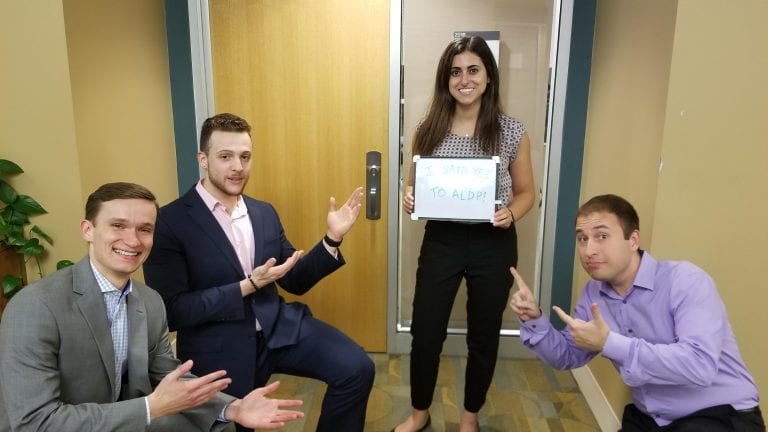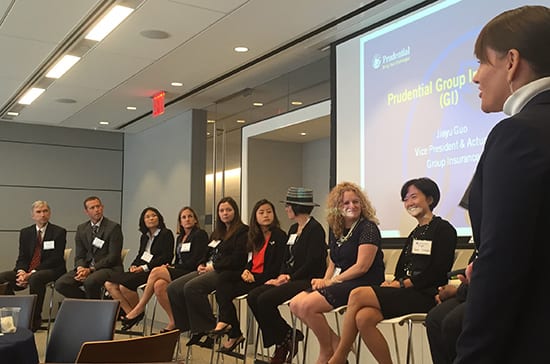When Your Leadership Development Program Is Losing Traction…
When Your Leadership Development Program Is Losing Traction…
Early career talent development programs need structured, formal training, measurable benchmarks, program staff members that support one another, and meaningful executive buy-in.
Take away any of these elements, and your program is likely to falter.
A few years ago, Prudential Financial’s Actuarial Leadership Development Program (ALDP) was losing traction. The current manager, Michelle Vallier, turned things around, and today she has advice for program managers who need a few words of advice.
The ALDP is a fast-track rotational program where 65-70 full-time associates get the technical, interpersonal, leadership and management skills required to become actuarial leaders. Michelle also oversees an internship program that feeds into the rotational program, and early awareness programs that expose high school students and college students to actuarial careers.
“Our goal is to develop high-potential leaders that can be deployed to actuarial and non-actuarial functions in the organization once they graduate,” Michelle says.
Meeting that goal has meant refurbishing ALDP’s reputation within the organization over the last several years.
“Sometimes we hear from associates that there’s animosity toward (the program) on their team, or the way people talk about the program isn’t always positive,” Michelle explains. “Essentially it goes back to being really honest about our product. “
The “product,” in this case is qualified leaders. Michelle admits that a few years ago there wasn’t a real difference between participants coming out of the program and new hires who didn’t go through leadership development. To put it another way, the ALDP wasn’t cultivating excellent leaders—and its reputation at Prudential reflected that.
“It can be boiled down pretty simply,” Michelle says. “We weren’t selling a consistent product at the end of the day. That was a reality that we had to face. We had to look at restructuring the program to ensure there was consistency in our graduates, that there was a higher quality in our graduates.”
Michelle says her program is “still on a path of recovery,” but she has seen a huge turnaround in manager engagement over the last couple of years.
“They believe in the restructuring and they see the value that it’s going to have. They’re re-buying into the program.”

Michelle Vallier
Now, if others in the organization question why ALDP associates get access, benefits and training that may be seen as preferential treatment, Michelle knows that the C-suite has her back and will defend the program. This renewed confidence in the program comes from measuring the results.
LDP Benchmarking
So, how are these results measured?
“On an annual basis, we revise the objectives that associates have to strive for during the course of the year,” Michelle explains. “These objectives are different from their general performance objective for their role. So they have a program-specific objective that they are measured against, plus their direct manager will provide separate objectives based on their project assignment.”
At the end of the year, a talent review brings together Michelle’s team, the rotation managers, HR, and the ALDP management team to talk about how each individual met their program and individual objectives.
This 2-3 day talent review allows them to keep a pulse on associates in the program. It also gives managers insight into how other managers measure associate achievement. These achievements include many things; one of them is the rate of placement of the associates post-graduation or, sometimes, even before graduation.
Other KPIs are related to recruiting targets—e.g., tracking how many associates are coming from core schools that Prudential has long-standing relationships with.
Michelle’s team is also working to better track alumni and the paths that they take after graduation, including what roles they’re in two, five, or eight years after graduation.
“Are they moving up in the organization or are they moving laterally? That’s something that we haven’t reported on more than anecdotally, but on an anecdotal basis, the results are really powerful. Our last two chief actuaries were graduates of our program and many of the senior leaders in our organization are graduates of the program.
Program Obstacles
With measurable results, Michelle has the data she needs to win over anyone in the organization who isn’t working with the program associates to the extent needed. If managers aren’t cooperating, for example, getting executive intervention is a lever she can pull to get things done.
“We talk to our most senior leaders about (obstacles). We know we have executive buy-in for the program. And since they see the value in the program, they can trickle down the message about the need for (corporation).”
This cooperation might include, for example, placing associates in a specific rotation. What’s Michelle’s advice for program managers who find themselves without the roles needed for all the associates in a rotation?
“We start by looking at the roles that our organization has open. Say we’ve been told by our senior leadership team that there are 50 open roles. If we need 20 roles filled (by ALDP associates), you might think those roles will be available to them.”
But not necessarily. Hiring managers may choose to submit the role for a full-time permanent hire rather than submitting it for someone in the program. Sometimes they have good reasons for this. For example, the role may need someone who won’t be transferring out in 12 months.
“But when we do need roles and we find ourselves in a deficit we try to dialogue with those managers about the give and take.” She helps them understand the benefits they gain by hosting a rotational associate.
“If they haven’t had luck filling a role with someone internally or externally, a lot of times we are able to convert the role to a rotation and that helps us make up the difference.”

Again, the program’s improved reputation has created opportunities,. Still, Michelle says she knows of one Prudential business are that remains “lukewarm” regarding her program’s mission.
“Honestly, it hasn’t helped them,” she says. “Students talk to each other and have expressed that it wasn’t a great environment.” (The business unit) needs the resources from the program, “But now they can’t get any interest from the associates. So they themselves are trying to rebuild their reputation with us.”
When middle-level management has reservations about a program, you have to address the reality of why they feel that way.
“I make calls to the leaders in those areas where associates haven’t had a great experience. I address it straight-on and let them know that we may consider whether or not that’s a role I would fill in the future if the environment is going to be toxic for the high-potential associates in our program.”
Restructuring Early Career Programs
So, why did Prudential’s actuarial LDP have such a lackluster track record when Michelle came on board? Part of the reason had to do with it being open-ended. Since the actuarial credentialing process requires a rigorous series of professional examinations, actuarial LDPs are often structured differently from other finance programs.
“Associates can take any length of time to pass the exams, so whereas other programs have a defined start and end time and the structure can be relatively straightforward, the belief in actuarial programs for a long time was that you couldn’t structure them because of that exam component.
“Before (the restructuring) it was a highly-curated, individualized experience. One person might have four rotations, plus a smattering of technical and non-technical rotations, and that would be okay.”
Shortly after inheriting the program, Michelle put a defined duration on the program and identified the key experiences and skillsets that graduates were expected to have.
“Today, there some key foundations that we’ve identified as requirements for the program. You can’t be considered a graduate unless you have your designation, you have checked off those requirements, and you have been performing adequately throughout the process.
“That has given us more clout with our naysayers. We’ve added more structure and we expect more of the people in the program.”
What does this structure look like?
For starters, program managers now have several connection points with all the stakeholders, including one-one-one discussions related to performance and promotions.
There are also annual information sessions to disseminate information about how to effectively manage rotations.
“Every time we have a rotation, we kick off the process with tactical updates. We connect with the managers a little more formally and less frequently, but around promotion time we connect with all managers to make sure our associates are being considered and so we know where everyone stands in their development.”
For associates, there are four one-on-one connection points every year. On a quarterly basis, at a minimum, managers meet with associates individually to talk about their experiences, whether or not they’re getting what they expect from the program, and how the managers can help them navigate the program.
“We also meet with them quarterly, as a group, to discuss program updates, give them the opportunity to hear from senior leaders across the organization, and do some fun things, like team-building exercises.”
In the end, pulling the ALDP at Prudential away from its faltering course has meant a healthier leadership pipeline for the company.
“We’re never in a position where we can not find roles for the people in the program,” Michelle says. “We put them through rigorous development and are appropriately selecting their rotational experience to ensure that the business is getting what they expect at the end of the day.”
image credits:
Prudential Actuarial associates photo courtesy of Actuarial Talent Network
Michelle Vallier and ALDP photos courtesy of LinkedIn.



